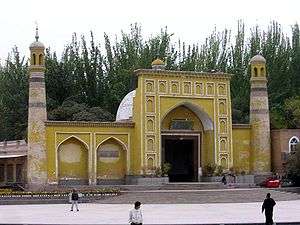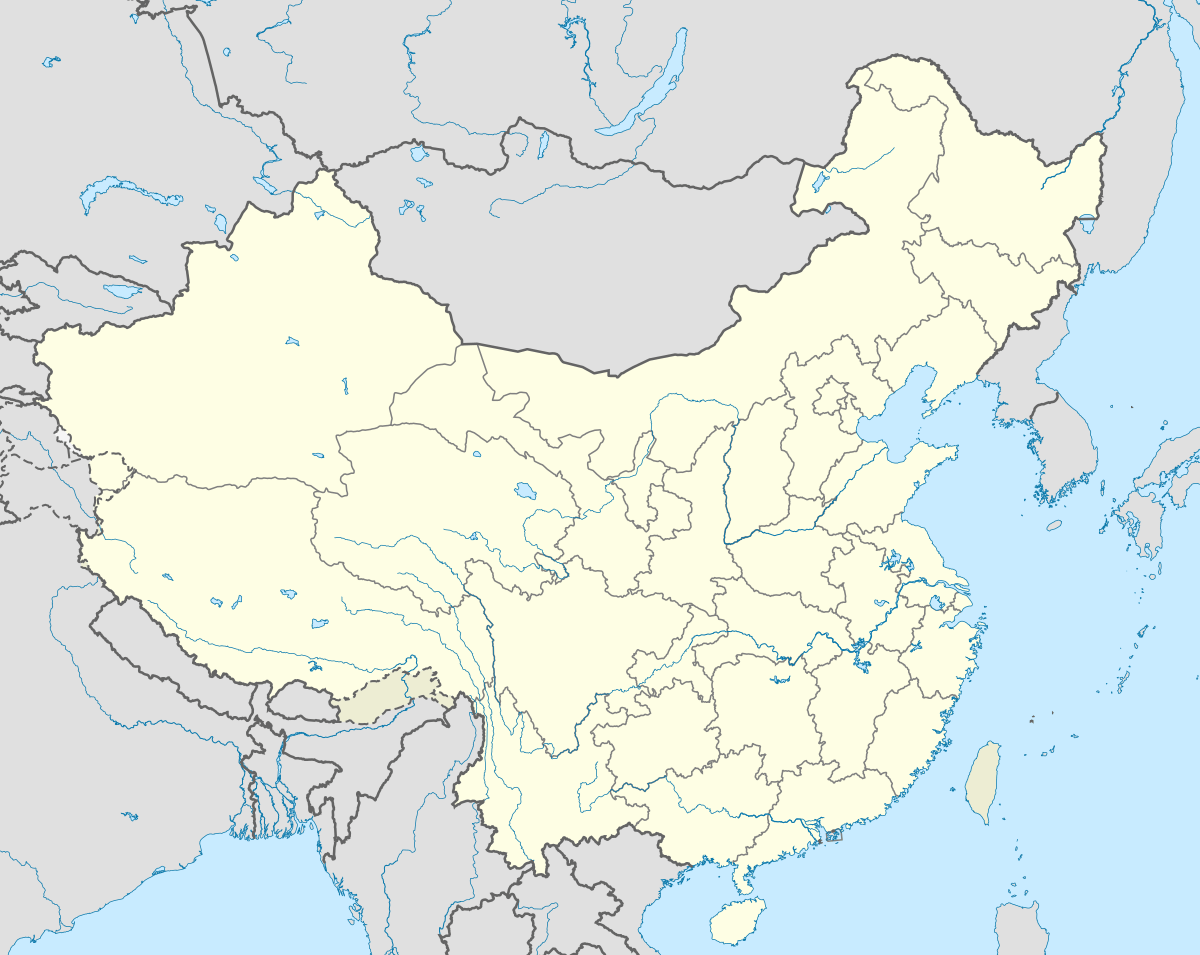Id Kah Mosque
The Id Kah Mosque (Uyghur: ھېيتگاھ مەسچىتى, ULY: Hëytgah Meschiti , USY: Хейтгах Месчити; Chinese: 艾提尕尔清真寺; pinyin: Ài Tí Gǎ Ěr Qīng Zhēn Sì; from Persian: عیدگاه, Eidgāh, meaning "Place of Festivities") is a mosque located in Kashgar, Xinjiang, China.
| مسجد عيدگاه Id Kah Mosque | |
|---|---|
艾提尕尔清真寺 Ài Tí Gǎ Ěr Qīng Zhēn Sì | |
 | |
| Religion | |
| Affiliation | Islam |
| Province | Xinjiang |
| Ecclesiastical or organizational status | Mosque |
| Location | |
| Location | Kashgar, Xinjiang, China |
 Shown within China | |
| Geographic coordinates | 39°28′20″N 75°59′03″E |
| Architecture | |
| Architect(s) | Saqsiz Mirza |
| Type | Mosque |
| Completed | 1442 |
| Specifications | |
| Capacity | 20,000 |
| Minaret(s) | 3 |
| Id Kah Mosque | |||||||
|---|---|---|---|---|---|---|---|
| Chinese name | |||||||
| Simplified Chinese | 艾提尕尔清真寺 | ||||||
| Traditional Chinese | 艾提尕爾清真寺 | ||||||
| |||||||
| Uyghur name | |||||||
| Uyghur | ھېيتگاھ مەسچىتى | ||||||
| |||||||
History
Id Kah is the largest mosque in Xinjiang and China. Every Friday, it houses nearly 10,000 worshippers and may accommodate up to 20,000.[1][2]
The mosque was built by Saqsiz Mirza in ca. 1442 (although it incorporated older structures dating back to 996) and covers 16,800 square meters.
The mosque's modern golden-brick structure was built in 1798 and was further expanded in 1832 to its current size.[3]
On 9 August 1933, Chinese Muslim General Ma Zhancang killed and beheaded the Uyghur leader Timur Beg, displaying his head on a spike at Id Kah mosque.[4][5][6][7]
In March 1934, it was reported that the Uyghur emir Abdullah Bughra was also beheaded, the head being displayed at Id Kah mosque.[8][9]
In April 1934, the Chinese Muslim general Ma Zhongying gave a speech at Id Kah Mosque in Kashgar, telling the Uyghurs to be loyal to the Republic of China Kuomintang government of Nanjing.[10][11][12]
On 30 July 2014, the imam of the mosque, hotelier Jume Tahir, was stabbed to death shortly after attending morning prayers.[13][14] His son Mamat Juma is the current imam.[15]
Allegations of religious persecution
Radio Free Asia reported that in 2018, a plaque containing Quranic scriptures, that had long hung outside the front entrance of the mosque, had been removed by authorities to "eliminate Uyghur faith, literary works, and language".[16]
However, in July 2020, the Chinese embassy in the US tweeted a video interview with the imam showing the plaque hanging inside the mosque, claiming that the mosque had been renovated.[17][15] The imam stated that the plaque had been moved inside to protect it from exposure to the rain and sun.[17]
See also
- Islam in China
- List of mosques in China
- List of famous mosques
- Timeline of Islamic history
- Islamic architecture
- Islamic art
References
- Peter Neville-Hadley. Frommer's China. Frommer's, 2003. ISBN 978-0-7645-6755-1. Page 302.
- "Id Kah Mosque in Kashgar of Xinjiang: History & Opening Hours". www.topchinatravel.com. Retrieved 2020-08-12.
- Steinhardt, Nancy Shatzman (2015). China's Early Mosques. Edinburgh: Edinburgh University Press. p. 268. ISBN 978-0-7486-7041-3.
- S. Frederick Starr (2004). Xinjiang: China's Muslim borderland. M.E. Sharpe. p. 77. ISBN 0-7656-1318-2. Retrieved 2010-06-28.
- James A. Millward (2007). Eurasian crossroads: a history of Xinjiang. Columbia University Press. p. 198. ISBN 0-231-13924-1. Retrieved 2010-06-28.
- Andrew D. W. Forbes (1986). Warlords and Muslims in Chinese Central Asia: a political history of Republican Sinkiang 1911–1949. Cambridge, England: CUP Archive. p. 93. ISBN 0-521-25514-7. Retrieved 2010-06-28.
- The British newspaper The Times reported that a turki chief was beheaded on August 25, 1933
- Christian Tyler (2004). Wild West China: the taming of Xinjiang. New Brunswick, New Jersey: Rutgers University Press. p. 116. ISBN 0-8135-3533-6. Retrieved 2010-06-28.
- Andrew D. W. Forbes (1986). Warlords and Muslims in Chinese Central Asia: a political history of Republican Sinkiang 1911–1949. Cambridge, England: CUP Archive. p. 123. ISBN 0-521-25514-7. Retrieved 2010-06-28.
- S. Frederick Starr (2004). Xinjiang: China's Muslim borderland. M.E. Sharpe. p. 79. ISBN 0-7656-1318-2. Retrieved 2010-06-28.
- James A. Millward (2007). Eurasian crossroads: a history of Xinjiang. Columbia University Press. p. 200. ISBN 0-231-13924-1. Retrieved 2010-06-28.
- Andrew D. W. Forbes (1986). Warlords and Muslims in Chinese Central Asia: a political history of Republican Sinkiang 1911–1949. Cambridge, England: CUP Archive. p. 124. ISBN 0-521-25514-7. Retrieved 2010-06-28.
- "Xinjiang imam killed after clashes". 31 July 2014. Retrieved 22 August 2018 – via www.bbc.co.uk.
- James T. Areddy (31 July 2014). "State-Appointed Muslim Leader Killed in China". The Wall Street Journal. Retrieved 1 August 2014.
- "Xinjiang mosques renovated, equipped with better amenities". news.cgtn.com. Retrieved 2020-08-12.
- "Removal of Islamic Motifs Leaves Xinjiang's Id Kah Mosque 'a Shell For Unsuspecting Visitors'". Radio Free Asia. Retrieved 2020-08-12.
- "Chinese Embassy in US". Twitter. Retrieved 2020-08-12.